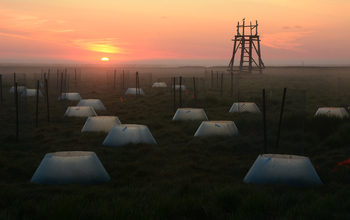Multimedia Gallery
Early morning at the Tutakoke River field camp
Early morning at the Tutakoke River field camp in the Yukon Delta National Wildlife Refuge in Alaska. Researchers from Utah State University are studying how the phenology of sub-Arctic tundra plants and the seasonal arrival of migratory Pacific black brants affects ecosystem functioning at the field site.
More about this image
This photo was taken by Ryan Choi, a Ph.D. candidate of wildlife ecology and a member of a National Science Foundation (NSF)-supported Arctic research project led by Karen Beard of Utah State University. The project is studying how a warming Arctic is affecting the relationships between migratory animals -- in this case Pacific black brants (Branta bernicla nigricans), a species of wild geese -- and the annual cycle of the forage they rely on for energy, nutrition and rearing of young. The study site is located in the Yukon Delta National Wildlife Refuge in Alaska.
Specifically, the researchers want to know how climate change is affecting goose arrival time and the start of the growing season in the Yukon-Kuskokwim Delta. Geese that breed and molt in Arctic ecosystems are extremely selective in what they forage, wanting high-quality (high nitrogen and low digestibility) food.
The Utah State team is conducting a highly manipulative experiment in which they are altering the timing of goose arrival (foraging) and the start of the growing season to investigate how these factors influence C and N cycling, the quality of forage and whether geese mediate the effects of climate change by altering soil and plant nutrition, vegetation canopy traits and plant demography.
The research is supported by NSF grant PLR 1304879 through the Arctic Systems Science program.
(Date image taken: 2014-2015; date originally posted to NSF Multimedia Gallery: July 14, 2016)
Credit: Ryan Choi, Utah State University
See other images like this on your iPhone or iPad download NSF Science Zone on the Apple App Store.
Images and other media in the National Science Foundation Multimedia Gallery are available for use in print and electronic material by NSF employees, members of the media, university staff, teachers and the general public. All media in the gallery are intended for personal, educational and nonprofit/non-commercial use only.
Images credited to the National Science Foundation, a federal agency, are in the public domain. The images were created by employees of the United States Government as part of their official duties or prepared by contractors as "works for hire" for NSF. You may freely use NSF-credited images and, at your discretion, credit NSF with a "Courtesy: National Science Foundation" notation.
Additional information about general usage can be found in Conditions.
Also Available:
Download the high-resolution JPG version of the image. (4.5 MB)
Use your mouse to right-click (Mac users may need to Ctrl-click) the link above and choose the option that will save the file or target to your computer.



 All images in this series
All images in this series